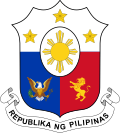| 4th Congress of the Philippines | |||||
|---|---|---|---|---|---|
| |||||
 | |||||
| Overview | |||||
| Term | January 27, 1958 – December 13, 1961 | ||||
| President | Carlos P. Garcia | ||||
| Vice President | Diosdado Macapagal | ||||
| Senate | |||||
| Members | 24 | ||||
| President | Eulogio Rodriguez | ||||
| President pro tempore | Fernando Lopez | ||||
| Majority leader | Cipriano Primicias Sr. | ||||
| Minority leader |
| ||||
| House of Representatives | |||||
| Members | 102 | ||||
| Speaker | Daniel Romualdez | ||||
| Speaker pro tempore | Constancio E. Castañeda | ||||
| Majority leader | Jose M. Aldeguer | ||||
| Minority leader | Cornelio Villareal | ||||
 |
|---|
The 4th Congress of the Philippines (Filipino : Ikaapat na Kongreso ng Pilipinas), composed of the Philippine Senate and House of Representatives, met from January 27, 1958, until December 13, 1961, during the second term of President Carlos P. Garcia.





